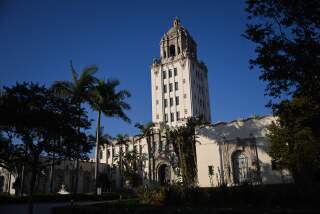Anaheim : Chevy Chase Project Goes on Priority List
- Share via
A plan to renovate the city’s Chevy Chase neighborhood and relocate more than 2,000 area residents inched closer to reality Tuesday when the City Council placed it on a priority list for tax-exempt financing.
The city now plans to ask state officials to use $13 million in tax-free bonds, already approved for a housing plan known as Emerald Village Senior Congregate Project, instead for the Chevy Chase project.
“We’re putting this one up higher because it serves a higher public purpose,” city Housing Development Coordinator Larry J. Cabrera said.
To complete raising the $25 million to $26 million needed to finance the Chevy Chase renovations, city officials also plan to request an additional $12 million to $13 million next year to make up the difference. Anaheim also will request another $13 million for the senior congregate project placed on hold this year, Cabrera said.
The Chevy Chase plan calls for the development firm owned by hamburger magnate Carl Karcher and developer Terrance K. Barry to buy and renovate almost 400 units. The mostly Latino families now living there, who are crowded into one and two-bedroom apartments, would be relocated with financial assistance.
According to a 1984 city-commissioned report, there are 3,000 people living in Chevy Chase, part of the larger Patrick Henry area of north Anaheim, directly south of the Riverside Freeway. But Cabrera said Tuesday that officials now estimate the number of residents in the neighborhood at 2,200.
City officials and others have hailed the project as a means to clean up the run-down, overcrowded area. But some Latino activists have been skeptical and have criticized the project, saying it would displace the predominantly Latino residents with more affluent, middle-class people.
The plan still has several important steps to go, Cabrera said, but he added that by next spring, the city hopes to have the financing and construction plans approved.
Part of the proposal involves the city’s agreeing to lend its power of condemnation to acquire 15% of the properties within the square-mile neighborhood if the company can acquire 85% of the properties from willing landlords. Relocation costs would be covered mostly by the developer.
More to Read
Sign up for Essential California
The most important California stories and recommendations in your inbox every morning.
You may occasionally receive promotional content from the Los Angeles Times.










